
Beginning Microsoft Word Business Documents - From Novice To Professional (2006)
.pdf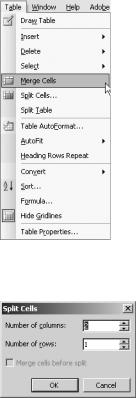
156 |
C H A P T E R 8 ■ C R E A T I N G A G R A N T O R B U S I N E S S P R O P O S A L |
Figure 8-26. Merging table cells
Figure 8-27. The Split Cells dialog box
Formatting Tables
If you didn’t specify an AutoFormat when you created your table, or if you want to change the format you applied, you can still format your table.
To apply formatting to the characters in your table, select the text and use the buttons on the Formatting toolbar to change character attributes.
If you want to change text alignment, change table alignment, or apply borders and shading, you’ll need to use the Table Properties dialog box, as shown in Figure 8-28. You can access this dialog box by selecting a portion of your table, right-clicking, and selecting Table Properties.
To change text alignment, open the Cell tab, shown in Figure 8-29, and specify text alignment properties. You can choose Top, Center, or Bottom. If you want to change text wrapping within cells, click the Options button. Specify whether you want text to wrap to the next line or to fit on one line. Click OK.
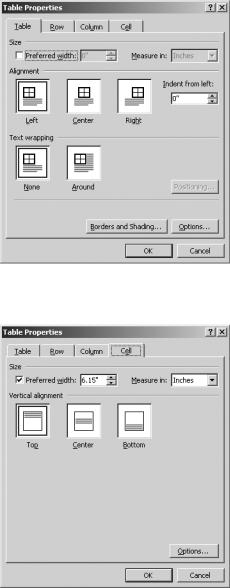
C H A P T E R 8 ■ C R E A T I N G A G R A N T O R B U S I N E S S P R O P O S A L |
157 |
Figure 8-28. The Table Properties dialog box
Figure 8-29. The Cell tab of the Table Properties dialog box
To change the table alignment, open the Table tab in the Table Properties dialog box, as shown in Figure 8-30. Select how you want Word to align the table on the page. For more control, you can specify a left indentation for the table.
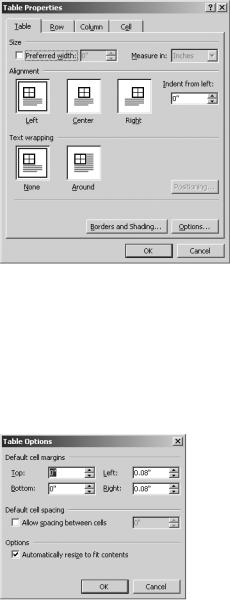
158 |
C H A P T E R 8 ■ C R E A T I N G A G R A N T O R B U S I N E S S P R O P O S A L |
Figure 8-30. The Table tab of the Table Properties dialog box
You also have the option of wrapping document text around the table. For business proposals, you should turn text wrapping off.
You can specify margins for text within the cell and padding between the cells. This allows you to space your data nicely across the page. To access these controls, shown in Figure 8-31, click the Options button.
Figure 8-31. Options for specifying cell margins and padding
If you want to add borders or shading to cells, click the Borders and Shading button. On the Borders tab, select the border style, color, and width (see Figure 8-32). There are
border presets that will apply the border style you choose to specific areas of the table. Or, you can click in the diagram on the right to specify where you want the borders to appear.
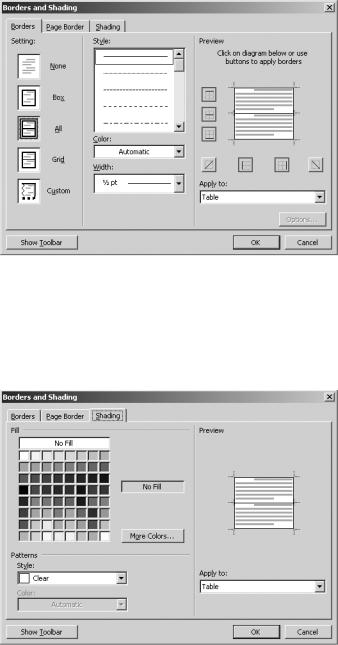
C H A P T E R 8 ■ C R E A T I N G A G R A N T O R B U S I N E S S P R O P O S A L |
159 |
Figure 8-32. Adding borders to a table
To specify shading, open the Shading tab, as shown in Figure 8-33. Select the color you would like to apply from the color chart. For more options, click More Colors. In the Patterns sections, you can select a shading pattern. Finally, click OK.
Figure 8-33. Adding shading to table cells
To change a table that you’ve AutoFormatted, click in the table. Click Table Table AutoFormat. In the Table AutoFormat dialog box, click Modify. In the Modify Style dialog box, shown in Figure 8-34, enter a new name for the table style. Then use the controls to
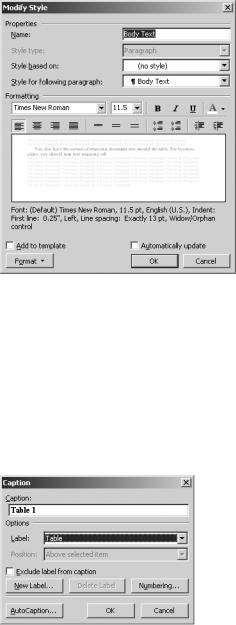
160 |
C H A P T E R 8 ■ C R E A T I N G A G R A N T O R B U S I N E S S P R O P O S A L |
change the table formats. When you’re done, click OK. Then close the Table AutoFormat dialog box.
Figure 8-34. The Modify Style dialog box
Adding Captions to Your Tables
You may want to add a caption to your table, as it helps you identify the table when you refer to it in your business proposal.
To insert a caption, select your table. Click Insert Reference Caption to bring up the Caption dialog box, shown in Figure 8-35. In the Label box, select the type of label. Then specify the position of the label. Enter the caption text in the box labeled Caption.
Figure 8-35. The Caption dialog box
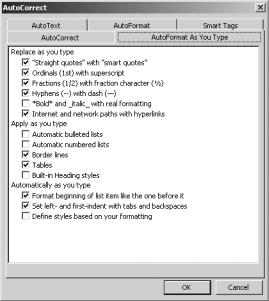
C H A P T E R 8 ■ C R E A T I N G A G R A N T O R B U S I N E S S P R O P O S A L |
161 |
Word inserts the caption as a field. The numbering updates automatically if you add more captions or rearrange captioned objects.
Creating Bulleted or Numbered Lists
There is a good chance that you will want to use bulleted or numbered lists in your document. These types of lists are notoriously difficult to work with in Word, although Word has significantly improved the way it handles lists.
Word generally tries to create a list if you begin a paragraph with a number or a symbol. When you end the paragraph by pressing Return or Enter, Word will AutoFormat the paragraph in a list style.
This AutoFormatting is frustrating for many users, particularly if a list is not desirable. And, if you have multiple paragraphs within a list item, it can be difficult to have Word format the list correctly.
I generally recommend that you disable lists in Word’s AutoFormat section. This will alleviate much of the frustration. To do this, click Tools AutoCorrect Options. On the AutoFormat As You Type tab, shown in Figure 8-36, deselect Automatic bulleted lists and Automatic numbered lists.
Figure 8-36. The AutoFormat As You Type tab of the AutoCorrect dialog box
On the AutoFormat tab, shown in Figure 8-37, deselect Automatic bulleted lists and List styles. Click OK.
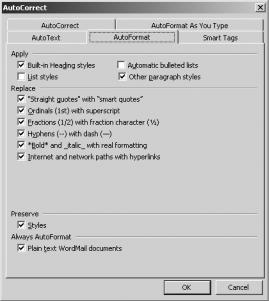
162 |
C H A P T E R 8 ■ C R E A T I N G A G R A N T O R B U S I N E S S P R O P O S A L |
Figure 8-37. The AutoFormat tab of the AutoCorrect dialog box
Now you can create the lists as you like by inserting numbers or symbols for list items. Then you can adjust the indents as you want. For some, creating lists manually is preferable to messing around with Word’s lists feature. However, keep in mind that lists won’t automatically update when individual list items are moved or deleted.
But, for short lists, it is much easier to let Word create the list for you. To begin a list, simply click either the Bullets or Numbering button on the Formatting toolbar.
When you create a list using the toolbar buttons, it is best to allow Word to format the list automatically. Then if you want to make changes to the format, you can do so in one fell swoop when the list is complete.
To change the format of a bulleted list, double-click one of the bullet points. The Bullets and Numbering dialog box opens, as shown in Figure 8-38. There are a number of predefined list formats from which you can choose. Simply highlight one of the styles and click OK.
Or, you can customize a list style by clicking the Customize button. In the Customize Bulleted List dialog box, which you can see in Figure 8-39, you have a number of options. You can choose from one of the existing bullet characters by selecting it. Or, you can select a different symbol by clicking the Character button. The Font button allows you to change the bullet symbol’s font.
In the Bullet position section, use the control box to select the indentation for the character. The Text position section changes the position of the text relative to the left margin. Tab space after sets the position of the first line of text. Indent at changes the position of all subsequent lines.
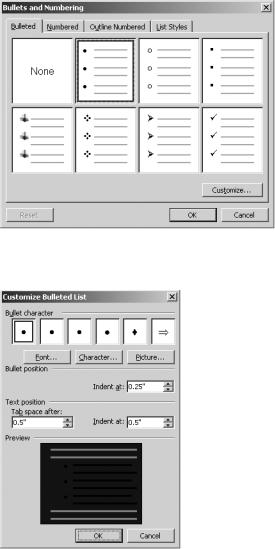
C H A P T E R 8 ■ C R E A T I N G A G R A N T O R B U S I N E S S P R O P O S A L |
163 |
Figure 8-38. The Bulleted tab of the Bullets and Numbering dialog box
Figure 8-39. The Customize Bulleted List dialog box
Once you have made your changes, click OK in each of the open dialog boxes.
To change the formatting of a numbered list, double-click one of the numbers. The Bullets and Numbering dialog box will open (see Figure 8-40). Again, Word gives you the option of selecting from a predefined format for numbered lists on the Numbered tab. Select one and click OK to apply it. Or, you can click Customize to make changes.
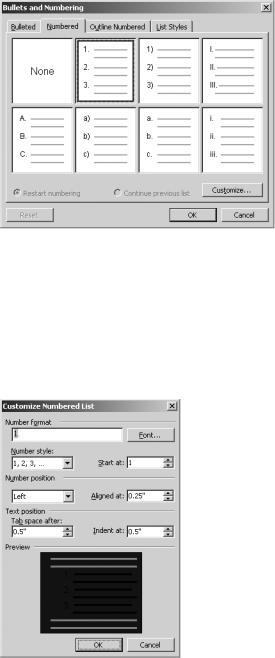
164 |
C H A P T E R 8 ■ C R E A T I N G A G R A N T O R B U S I N E S S P R O P O S A L |
Figure 8-40. The Numbered tab of the Bullets and Numbering dialog box
In the Number format box of the Customize Numbered List dialog box, you can enter a number and a character, if you want a special format (see Figure 8-41). The Font button provides a way for you to change the font format for the list numbers. You can use the Number style box and the Start at box to apply a specific style of numbering and to change the number at which the list will start.
Figure 8-41. The Customize Numbered List dialog box

C H A P T E R 8 ■ C R E A T I N G A G R A N T O R B U S I N E S S P R O P O S A L |
165 |
■Tip If you are continuing a previous list, don’t use the Start at option to change the list. If you delete an earlier list item, the current list won’t automatically update. Rather, use the Continue previous list option in the Bullets and Numbering dialog box.
In the Number position section, use the control box to select the indentation for the number. The Text position section changes the position of the text relative to the left margin. Tab space after sets the position of the first line of text. Indent at changes the position of all subsequent lines.
Once you have made your changes, click OK in each of the open dialog boxes.
If you want to remove a bullet point or number from a paragraph, simply position the cursor before the first character in the paragraph text. Then press the Backspace key. The bullet or number will be removed; the rest of the list updates automatically.
At the end of a list, press Enter or Return twice to turn off bullets and numbering and to return to a normal paragraph style.
Numbering Pages with Footers
You should add page numbers to your business proposal. Footers are ideal for listing page numbers—and any additional information.
Page numbers in the footer ensure that the business proposal can be reordered easily, should someone separate the pages. You should not number the cover page. However, if the table of contents runs over one page, you may want to number it.
To number the table of contents, place your cursor at the top of the first page. Click View Header and Footer. Click the Page Setup button on the Header and Footer toolbar to bring up the Page Setup dialog box shown in Figure 8-42. Use the controls to specify the distance from the edge of the paper. In the Preview section, select This point forward. Click OK.
Scroll down and click within the footer box. On the Formatting toolbar, click the Right Alignment button. Then on the Header and Footer toolbar, click the Insert Page Number button. Click the Format Page Number button. In the Page Number Format box, shown in Figure 8-43, select the number format. For a table of contents, use lowercase Roman numerals. Under Page numbering, select Start at and use the controls to select “i.” Click OK.
